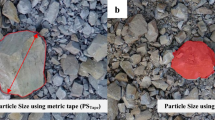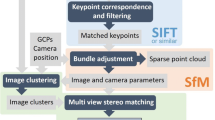Abstract
Underground caves bear a natural hazard due to their possible evolution into a sink hole. Mapping of all existing caves could be useful for general civil usages as natural deposits or tourism and sports. Natural caves exist globally and are typical in karst areas. We investigate the resolution power of modern gravity campaigns to systematically detect all void caves of a minimum size in a given area. Both aerogravity and terrestrial acquisitions are considered. Positioning of the gravity station is fastest with GNSS methods the performance of which is investigated. The estimates are based on a benchmark cave of which the geometry is known precisely through a laser-scan survey. The cave is the Grotta Gigante cave in NE Italy in the classic karst. The gravity acquisition is discussed, where heights have been acquired with dual-frequency geodetic GNSS receivers and Total Station. Height acquisitions with non-geodetic low-cost receivers are shown to be useful, although the error on the gravity field is larger. The cave produces a signal of −1.5 × 10−5 m/s2, with a clear elliptic geometry. We analyze feasibility of airborne gravity acquisitions for the purpose of systematically mapping void caves. It is found that observations from fixed wing aircraft cannot resolve the caves, but observations from slower and low-flying helicopters or drones do. In order to detect the presence of caves the size of the benchmark cave, systematic terrestrial acquisitions require a density of three stations on square 500 by 500 m2 tiles. The question has a large impact on civil and environmental purposes, since it will allow planning of urban development at a safe distance from subsurface caves. The survey shows that a systematic coverage of the karst would have the benefit to recover the position of all of the greater existing void caves.

















Similar content being viewed by others
References
A. Marussi GNSS network (2015), The GNSS stations are described in the home page of the network, http://www.regione.fvg.it/rafvg/cms/RAFVG/ambiente-territorio/strumenti-per-conoscere/FOGLIA1/.
Battaglia, M., Zuliani, D., Pascutti, D., Michelini, A., Marson, I., Murray, M.H., and Burgmann, R. (2003), Network Assesses Earthquake Potential in Italy’s Southern Alps, Eos 84, 262–264.
Braitenberg, C., Romeo, G., Taccetti, Q., Nagy, I. (2006), The very-broad-band long-base tiltmeters of Grotta Gigante (Trieste, Italy): secular term tilting and the great Sumatra-Andaman Islands earthquake of December 26, 2004, J. of Geodynamics 41, 164–174.
Braitenberg, C., and Zadro, M. (2007), Comparative analysis of the free oscillations generated by the Sumatra-Andaman Islands 2004 and the Chile 1960 earthquakes, Bulletin of the Seismological Society of America 97, S6–S17 doi: 10.1785/0120050624.
Braitenberg, C., and Nagy, I. (2014), Illustrating the superposition of signals recorded by the Grotta Gigante pendulums with musical analogues, Acta Carsologica 43/1, 139–147.
Caldera, S., Realini E., Barzaghi R., Reguzzoni M., and Sansò F. (2015), An experimental study on low-cost Geodetic monitoring, Submitted to Journal of Surveying Engineering.
Cucchi, F., Casagrande, G., Manca, P., and Zini, L. (2001), Il Timavo ipogeo tra l’Abisso di Trebiciano e la Grotta Meravigliosa di Lazzaro Jerko, Le Grotte d’Italia 2, 39–48.
Davis, P. J., Interpolation and approximation (Courier Corporation, Mineola 1975).
Demeure, C. J., and Scharf, L. L. (1987), Linear statistical models for stationary sequences and related algorithms for Cholesky factorization of Toeplitz matrices, Acoustics, Speech and Signal Processing, IEEE Transactions 35, 29–42.
Department Of Primary Industries, Victoria (2012), Gippsland Nearshore Airborne Gravity Survey—Data Package.
Devoti, R., Zuliani, D., Braitenberg, C., Fabris, P. and Grillo, B. (2015), Hydrologically induced slope deformations detected by GPS and clinometric surveys in the Cansiglio Plateau, southern Alps, Earth and Planetary Science Letters 419, 134–142, doi:10.1016/j.epsl.2015.03.023.
Farr, T.G., Rosen, P.A., Caro, E., Crippen, R., Duren, R., Hensley, S., Kobrick, M., Paller, M., Rodriguez, E., Roth, L., Seal, D., Shaffer, S., Shimada, J., Umland, J., Werner, M., Oskin, M., Burbank, D., and Alsdorf, D. (2007), The Shuttle Radar Topography Mission, Rev. Geophys. 45, RG2004, doi:10.1029/2005RG000183.
Fingolo, M., Facco, L., Ceccato, A., Breganze, C., Paganini, P., and Cezza, M. (2011), Tra realta’ virtuale e rilievi 3D ad alta risoluzione, Veneto Geologi 75, 21–25.
Ford, D. and Williams, P., Karst Hydrology and Geomorphology, (Wiley, Chirchester, 2007).
Franklin, J. N. (1965), Numerical simulation of stationary and non-stationary Gaussian random processes, SIAM review 7, 68–80.
Geonet (2015), http://sourceforge.net/projects/geonet/?source=directory, last access September 1, 2015.
Harlan, R. B. (1968), Eotvos corrections for airborne gravimetry, Journal of Geophysical Research 73, 4675–4679.
Heiskanen, W. A., and Moritz, H. Physical Geodesy, (Technical University, Graz 1981).
Herrera, A. M., Suhandri, H. F., Realini, E., Reguzzoni, M., and de Lacy, M. C. (2015), goGPS: open-source MATLAB software. GPS Solutions, 1–9.
Hofmann-Wellenhof, B., Lichtenegger, H., and Wasle, E., GNSS–global navigation satellite systems: GPS, GLONASS, Galileo, and more, (Springer Wien New York, Wien 2008).
Lawson, C. L., and Hanson, R. J., Solving least squares problems (Prentice-Hall, Englewood Cliffs 1974).
Leick, A. GPS satellite surveying (Wiley, Hoboken 2004).
Li, B., Verhagen, S. and Teunissen, P.J.G., GNSS Integer Ambiguity Estimation and Evaluation: LAMBDA and Ps-LAMBDA, In China Satellite Navigation Conference (CSNC) 2013 Proceedings, Lecture Notes in Electrical Engineering 244 (eds. Jiadong, S., Wenhai, J., Haitao, W., and Chuang, S.) (Springer, Berlin 2013) pp. 291–301.
Paganini, P., and Pavan, A. (2012), Rilievo laser-scanner della Grotta Gigante: Relazione Tecnica, Progressione. Supplemento semestrale ad “Atti e memorie” 58, 129–132.
Park, J., Song, T. A., Tromp, J., Okal, E., Stein, S., Roult, G., Clevede, E., Laske, G., Kanamori, H., Davis, P., Berger, J., Braitenberg, C., van Camp, M., Lei, X., Sun, H., Xu, H., and Rosat, S. (2005), Earth’s free oscillations excited by the 26 december 2004 Sumatra-Andaman earthquake, Science 308, 1139–1144.
Pivetta, T., and Braitenberg, C. (2015), Laser-scan and gravity joint investigation for subsurface cavity exploration—the Grotta Gigante benchmark, Geophysics 80, B83–B94.
Rossi, L., Sampietro, D., and Sansò, F. (2012), GeoNet: un software per la compensazione di reti topografiche integrate, Proceedings of 16th National conference ASITA, 1157–1164.
Realini, E., and Reguzzoni, M. (2013), goGPS: open source software for enhancing the accuracy of low-cost receivers by single-frequency relative kinematic positioning, Measurement Science and Technology 24, 115010.
Shako, R., Förste, C., Abrikosov, O., Bruinsma, S., Marty, J. C., Lemoine, J. M., and Dahle, C., EIGEN-6C: A high-resolution global gravity combination model including GOCE data, In Observation of the System Earth from Space-CHAMP, GRACE, GOCE and future missions (eds. Fletchner, F., Sneeuw, N., and Schuh, W-D.) (Springer, Berlin 2014) pp. 155–161.
Tenze, D., Braitenberg, C., and Nagy, I. (2012), Karst deformations due to environmental factors: evidences from the horizontal pendulums of Grotta Gigante, Italy, Bollettino di Geofisica Teorica ed Applicata 53, 331–345, doi:10.4430/bgta0049.
Tsuji, H., Miyagawa, K., Yamaguchi, K., Yahagi, T., Oshima, K., Yamao, H., and Furuya, T. (2013), Modernization of GEONET from GPS to GNSS, Bulletin of the Geospatial Information Authority of Japan 61, 9–20.
Uieda, L., Ussami, N., and Braitenberg, C. F. (2010), Computation of the gravity gradient tensor due to topographic masses using tesseroids, EOS, Trans. Am. Geophys. Un., 91(26).
Uieda, L., Bomfim, E. P., Braitenberg, C., and Molina, E. (2011), Optimal forward calculation method of the Marussi tensor due to a geologic structure at GOCE height, Proc. of ‘4th International GOCE User Workshop’, Munich, Germany, 31 March–1 April 2011 (ESA SP-696, July 2011).
Verhagen S., and Li B. (2012), LAMBDA—Matlab implementation, version 3.0, Delft University of Technology and Curtin University.
Visintin, L. (2011), Realizzazione di un SIT finalizzato allo studio delle aree carsiche, PhD Thesis, University of Trieste, Trieste, http://www.openstarts.units.it/dspace/handle/10077/4513.
Wanninger, L. (2003), Virtual reference stations (VRS), GPS Solutions 7, 143–144.
Watson, G. N., A treatise on the theory of Bessel functions (Cambridge University Press, Cambridge 1995).
Zadro, M., and Chiaruttini, C. (1975), Loading effects of the Mediterranean tides, Proc. of the Seventh International Symposium on Earth Tides, Sopron, 1973. (Akademiai Kiado, Budapest) pp 405–501.
Zanolla, C., Coren, F., Cucchi, F., Giorgetti, F., and Lovo, M. (1996), Elaborazione dei dati gravimetrici in corrispondenza della Grotta Gigante (Carso Classico, Trieste, Italia), Atti e Memorie della Commissione Grotte “E. Boegan” 33, 17–24.
Zuliani, D., Battaglia, M., Pascutti, D., Murray, M., Burgmann, R., Michelini, A., and Marson, I. (2003), FReDNet: a continuous GPS geodetic network to monitoring crustal deformation in NE Italy, EGS-AGU-EUG Joint Assembly 1, 2120.
Acknowledgments
We acknowledge the former director of the Grotta Gigante cave, Arch. A. Fabbricatore, for providing us the laserscan data and for the logistic support. The guides of the Grotta Gigante are gratefully thanked for their support in the density sampling campaign. The authors acknowledge Prof. Daisuke Yoshida of Osaka City University, and Dr. Eugenio Realini and Dr. Stefano Caldera of GReD for providing the u-blox data collected under the JSPS KAKENHI Grant Number 26730156. We thank Dr. S. Cirilli and Dr. F. Raicich for providing tide gauge data of Trieste harbor. We thank Thomas Jahr and an anonymous reviewer for the meticulous reviews.
Author information
Authors and Affiliations
Corresponding author
Electronic supplementary material
Below is the link to the electronic supplementary material.
Rights and permissions
About this article
Cite this article
Braitenberg, C., Sampietro, D., Pivetta, T. et al. Gravity for Detecting Caves: Airborne and Terrestrial Simulations Based on a Comprehensive Karstic Cave Benchmark. Pure Appl. Geophys. 173, 1243–1264 (2016). https://doi.org/10.1007/s00024-015-1182-y
Received:
Revised:
Accepted:
Published:
Issue Date:
DOI: https://doi.org/10.1007/s00024-015-1182-y




